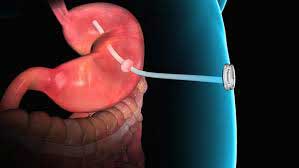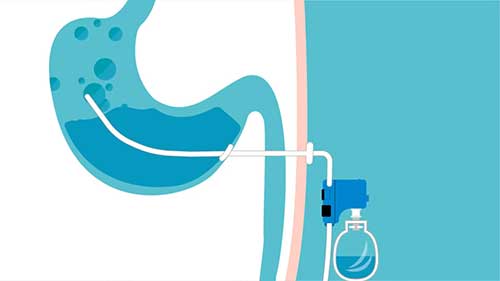 On June 14, 2016, the FDA issued a press release stating they had approved the use of a new weight loss device called AspireAssist. The FDA does not approve new anti-obesity treatments often, so it’s pretty big news, but AspireAssist is only approved for people with a Body Mass Index (BMI) of 35 to 55, and the treatment requires a doctor’s recommendation. It is also unlikely to be suitable for the faint-hearted because AspireAssist is a stomach tube that is fitted to the body via a small incision, and then used after meals to drain of percentage of food from the stomach.
On June 14, 2016, the FDA issued a press release stating they had approved the use of a new weight loss device called AspireAssist. The FDA does not approve new anti-obesity treatments often, so it’s pretty big news, but AspireAssist is only approved for people with a Body Mass Index (BMI) of 35 to 55, and the treatment requires a doctor’s recommendation. It is also unlikely to be suitable for the faint-hearted because AspireAssist is a stomach tube that is fitted to the body via a small incision, and then used after meals to drain of percentage of food from the stomach.
Who Manufactures the AspireAssist Weight Loss Device?
Content
AspireAssist is made in American by Aspire Bariatrics. The company operates an impressive website that contains a staggering amount of information about the device, how it works, what users can expect, and what people who have used the device have to say. Few if any diet supplement manufacturers provide so much information about their products, but Aspire’s decision to educate potential users is a good one because making the decision to buy a diet pill is a far cry from deciding whether or not to have a tube implanted in your stomach.
Who is the Device Intended For?
AspireAssist is designed to help people who suffer from obesity, have a BMI 35 to 55, and have failed to achieve or maintain weight loss through more conventional means.
People who are considering having the device fitted need to be seriously committed to losing weight and have a good understanding of the emotional and environmental triggers that cause their unhealthy eating behaviour.
How Does the AspireAssist Stomach Tube Work?
Like any other weight loss method, AspireAssist is designed to help people to lose weight by reducing their daily intake of calories. It’s very invasive compared to a diet pill, but not nearly so invasive as gastric band surgery.

A good appetite suppressing diet pill works by causing the user to lose the desire to eat so much food. Gastric band treatment restricts the space available inside the stomach so there is less room for food. Dieter who have an AspireAssist stomach tube fitted have the ability to drain the contents of their stomach instead.
When the body does not get all the calories it needs it is forced to burn fat to gain extra energy. AspireAssist is just a new way of achieving this state.
How is the Tube Installed?
Unlike a gastric band, the AspireAssist food tube can be installed on an outpatient basis. According to the documentation on the Aspire website, a thin tube is inserted into the stomach and connects to a “discreet button” that enables patients to aspirate (empty) up to 30% of their stomach contents into the toilet.
How is the Stomach Emptied?
The stomach is emptied via a small hand-held device that connects to the button. It comes complete with its own travel case and the aspiration process generally takes 20 to 30 minutes.
Are There Any Health Considerations or Dangers Involved?
AspireAssist is not recommended for anyone who suffers from a disease or disorder that causes “extreme difficulty swallowing or digesting food”. It may also be unsuitable for people who have stomach ulcers or have undergone radiation therapy to the chest or abdomen. And it goes without saying the AspireAssist is not a safe option for women who are pregnant or nursing a child.
Other conditions that may make the AspireAssist stomach tube unsuitable include:
- Anaemia
- Bulimia
- Binge eating
- High blood pressure
- Blood clotting disorders
- Night eating syndrome
- Lung or heart disease
- Chronic abdominal pain
The Aspire website states the most common side effects include pain and discomfort, nausea/vomiting, and skin irritation. There is also a possibility that the procedure will lead to an infection that may have to be treated with antibiotics.
What is the Expected Weight Loss?
The data collected from scientific studies suggest people who use the device for a year may loose about 12% of their body weight. That’s 1% a month. However, as with any other weight loss system, people who eat a healthy diet and take regular exercise will attain the best results.
Is the Procedure Easy to Reverse?
Given the abundance of information the available on the Aspire website, the fact that there is no information about how the device is removed is rather surprising. In fact, people who have attained their ideal weight, and are considering removing the device, are advised to just stop using it and see if they can go it alone and maintain the weight they’ve achieved.
An extract taken from the site’s FAQs page reads:
[plain]”Our trials show that most patients who start this therapy elect to continue it to ensure that weight loss is maintained. However, if the AspireAssist is needed to maintain weight loss, it is likely weight regain will occur if therapy is stopped.”[/plain]
Concluding Thoughts
It seems highly likely that this device could help people to lose weight, but it has many disadvantages. Even people suffering from severe constipation are unlikely to spend 30 minutes in the rest room. Having to do so after each and every meal could be very inconvenient and, unless you are working from home, lunchtimes may be particularly hectic and embarrassing. In this respect gastric band surgery and diet supplements appear to be a much better option. The AspireAssist also has the potential to ensure Summer vacations are changed forever. Few people would be willing to bare their stomach and display their “discreet button” on the beach or beside the pool. Those first intimate moments with a new partner could also prove to be embarrassing and could conceivably be the last. Having an AspireAssist stomach tube fitted is not a decision to be taken lightly.
Read about Bariatric Arterial Embolization – New Obesity Injection

Be the first to comment